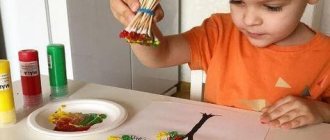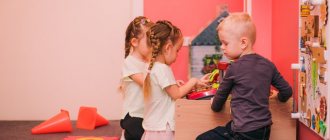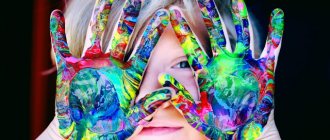Creative imagination is the “engine” that launches the creation of a completely new work or image. Thanks to this mental process, people received masterpieces of art, great inventions and discoveries. And no matter how significant the result, the origins of achievements should be sought in childhood, when the potential of the cognitive sphere begins to form. Therefore, it is important to know how the development of creative imagination occurs in preschoolers, and how to develop personality in this direction.
Brief description of the process
Psychologists insist that creative imagination is special. This is an active learning process.
The imagination can work even in a dream, giving rise to stories, one more incredible than the other. But in this case the nature of the process is passive. Imagination can also be reconstructive, helping to imagine an already familiar object, phenomenon or event. The named types have little to do with creativity. Creative imagination is characterized by novelty and originality of the result. Known schemes and ready-made descriptions are used partially or not at all.
Distinctive features of a child's creative imagination
The imagination of a preschooler, like all cognitive processes at this age, most often acts involuntarily. It is still inappropriate to talk about special plans and goals characteristic of the boundless flight of thought. But active imagination and the desire to try out many things from one’s own experience indicate the beginning of the development of creative imagination in preschool children. Signs of creativity are clearly visible.
- Brightness and originality of fantasies and images
Children create incredible stories in which they give toys or ordinary objects “magical” properties. This happens because preschoolers are immersed in the world of fairy tales and cartoons. They may imagine themselves as characters from a fairy tale and be creative in describing the character's strengths or frightening traits. In addition, the child’s experience is not sufficient to understand the phenomena of the world around him, and he himself comes up with explanations for them.
- Active use of well-known images in new conditions
Developing creative abilities, the child repeats himself less and less often and more often practices creating new images, placing fictional characters in different situations. For example, an older preschooler is able to compose several stories about a fairy-tale hero. The image of the hero is the result of the work of creative imagination, and numerous stories with his participation appear due to the growth in the content of the child’s creativity.
The imaginary plot is embodied in the drawing
The fact that a child’s idea of something often goes beyond the usual boundaries also speaks about creative imagination. So, when completing the task of drawing rain in a fairyland, children imagine it as a shooting star, candy or flower rain.
What primarily distinguishes creative thinking?
- It is connected mainly not with consciousness, but with the subconscious (that is, the child is not aware of the true goals and motives that guide him)
- It is aimed at carrying out specific types of activities and interaction with the environment
- Expressed not in words, but in symbols and images
- May remain incomprehensible to others
Imagination, as a function of the psyche, is in close connection with speech. That is why psychologists note that often it is the delay in speech development that very often leads to impairments of the imagination. The connection between imagination and speech is manifested mainly in the fact that speech gives the child the opportunity to verbally express his impressions, emotions and experiences. And also operate in your mind with concepts, the stock of which will expand from year to year. In addition, children's imagination has a number of distinctive qualities.
What is imagination - definition
When a preschooler is receptive to the development of creative imagination
In psychology, the stages of development of the creative imagination of preschoolers are conventionally distinguished.
The initial stage appears when children, already knowing the real purpose of an object, use it in a new capacity. A replacement appears, but only an object that is somewhat similar (shape, color...) is assigned to the role of “substitute”. For example, imitating measuring temperature, a preschooler will take a stick as a thermometer; and handing an orange ball to a peer, he will start talking about orange.
During this age period, it is useful to show your child how to find new uses for ordinary materials. For example, you can show him different ways of drawing - with a brush, pencil, charcoal, chalk, etc.
Drawing with children 3-4 years old does not mean creating specific drawings. Kids depict scribbles, spots, chaotic strokes. And then, with the help of adults, they see something in the drawn lines and curls. At this age, it is important to broaden the child’s horizons so that he develops a stock of knowledge on which he will rely in his creativity.
From reality to fantasy images
At the next stage, at 4-5 years old, previously acquired skills are improved. Fantasy is still based on the idea of a real object, and new images appear unintentionally. Therefore, even a 5-year-old child will rarely respond to an offer to compose a fairy tale. He is not yet able to complete such a task at the request of an adult.
Younger preschoolers can perform certain actions and then tell what happens in their game or activity. This means that the intention is formed after the action. In such situations, creative imagination also takes place, but its level is only initial.
Children 6-7 years old can already demonstrate independent creative activity. They are able to choose a goal, formulate a creative idea and strive to realize their plans. Imagination is based on the development of creative abilities in preschool children. Older children are already able to include any small element into the overall composition, imagine the expected result before it appears, combine disparate details with one idea, etc.
At this stage, the process of fantasy itself captivates. Parents often notice that their son or daughter comes up with ideas “on the fly.” This skill is especially evident in the writing of stories by older preschoolers. A significant breakthrough occurs due to the general development of the child’s cognitive sphere and the enrichment of speech.
Directions for the development of creative imagination in preschoolers
The development of creative abilities requires stimulation and a systematic approach. In order for a preschooler’s imagination to be distinguished by originality and boldness of ideas, it is necessary to expand the techniques and the stock of concepts that the child could use in fantasy.
It is necessary to help children accumulate impressions and awaken their interest in art. Important:
- do not limit the spontaneity of creative expression
- guide in finding creative solutions
- welcome the child's independence
- show him new available materials for creativity.
Let us dwell on those types of activities that most effectively stimulate the development of imagination at this age stage.
Visual activities
Drawing becomes a field for a child’s creative self-expression earlier than other activities. Already at an early preschool age, children draw circles and other simple shapes, putting their own meaning into these images. Every year the filling of children's drawings with details increases. The preschooler learns to highlight the details of a holistic image, or, conversely, to create a multifaceted image based on a given element.
A task like “Complete the figure”, “Draw 5-8 different drawings based on the figure”, etc. stimulates the search for new images.
An older preschooler is able to form a creative idea and imagine the final artistic image, which will be embodied on a sheet of paper, canvas or... asphalt. You should not limit it to a narrow framework or a specific task. You can ask them to come up with a name for your drawing first.
Didactic game as a means of developing creative potential
The use of didactic materials provides ample opportunities for developing the imagination of a preschooler. Imagination and creativity can be developed by offering children various pictures (fables, parts of an image) or by involving children in games with objects, or by offering verbal forms of tasks (figure out how ...; complete the story).
Didactic games are valuable because they encourage children to fantasize and form the arbitrariness of the creative process. The game creates conditions in which the child can look at a familiar object in a new way. The tasks encourage him to think about things in which he himself is not sufficiently interested.
Creative imagination in design
Working with a construction set helps preschoolers understand how new images are created, how to combine parts in a different, unusual way.
Construction is especially useful because children test their ideas immediately: as soon as certain outlines flash in their imagination, they immediately try to make the presented image.
Construction involves the use of more than just a specific set of parts.
Images can be sculpted from plasticine or clay. Modeling stimulates the development of creative imagination, allowing you to experiment with shape and size. Of course, a child will not immediately cope with a complex task, for example, sculpting a fairy-tale animal. The role of an adult is important here, who will select tasks available to the preschooler, gradually complicating them.
The effect of music on the imagination
Music is a special condition for the development of creative imagination, since when used skillfully it improves and enriches the auditory perception of a preschooler. First, at the suggestion of an adult, children try to catch the sound of notes, either raindrops, the sound of footsteps, or the rustling of leaves.
With systematic lessons, the preschooler gradually develops the skill of listening to the sounds that fill the space. Music, as a means of activating the creative imagination of preschoolers, provides additional material that will color children’s fantasies and will contribute to their more vivid expression.
So, despite the fact that creative imagination is characteristic of preschool age, it is necessary to stimulate its development. By supporting children's interest in creativity and organizing special activities, adults help the preschooler develop, along with imagination, other cognitive processes - thinking, memory, attention, perception.
How to develop imagination and fantasy in adults
“Imagination is everything. This is a preview of life's upcoming attractions." Albert Einstein.
Imagination is an ability that is inherent in every person. Therefore, he does not need to learn, he just needs to be stirred up.
To develop imagination, it is enough to perform actions that stimulate it. Below is a list of recommendations that I found to be the simplest and most effective.
Turn off the TV and find a hobby
Watching TV is a common way to relieve stress after a hard day at work. I myself also like to watch a couple of episodes of the series on my day off or before going to bed. But this is a way of passive rest, in which the brain is inactive.
Instead of constantly observing other people's lives, find a hobby that allows you to create your own story.
Pay attention to funny little things
Try to find strange and funny things where there are none. An absurd combination of inscriptions on nearby billboards, a bizarre shape of clouds, a funny gait of a pigeon. It all requires a little imagination and can make your life a little more fun (a nice bonus).
For example, my sister’s cat Aliska froze in the pose of a cowboy shooting back from the Indians. And yes, I know that cowboys are just cowherds.
Try doing nothing
Our mind is constantly in a noisy environment due to external impulses. This could be the same TV, music, constant communication on social networks and the notification pipeline. Try sitting in silence and listening to your own thoughts. Sometimes you can be amazed at what ideas and conclusions come to mind when there is nothing to distract you.
Listen to music without words
Listening to music has been proven to improve productivity while working. But if these are songs with lyrics, we subconsciously listen to their ideas, leaving our own behind. I notice for myself that even songs in a language I don’t know can confuse my thoughts. On the other hand, music without lyrics stimulates your imagination and gives the green light to new ideas.
While working on articles, I listen to music in the style of Trance, Deep or Ambient. I love Drum'n'Bass, but you can only dig trenches for it. Scientists recommend listening to jazz, blues and classical music, but to each their own.
Read different books
Even if you regularly read fiction, this can also become a kind of comfort zone. The brain requires different content. If you usually read science fiction, read a detective story, it will give you a new experience and expand your imagination.
Watch movies with twisted plots
Now as for the films. I said that it is better to limit TV viewing. But there are films that challenge the conventional method of storytelling. Films with a non-linear plot, in which it is very difficult to predict the events or ending, are suitable. For example, the film “Shutter Island” with DiCaprio. This way you won't let your imagination rest.
Write to your heart's content
First, make it a habit to write down interesting thoughts . This way, you can return to them after reviewing your notes and develop new ideas.
Secondly, writing on a free topic is recommended as a therapeutic relaxation and can greatly stimulate your imagination. Try to simply describe your typical day, even if it was the most boring one. Write how events might have unfolded if you had made different choices in different situations. If you know how to rhyme, write a short poem about something ordinary, showing familiar things from a different, beautiful or funny side. For example:
I'm sitting at the table and he's older than me. Someone used to sit behind you, but not me. Maybe someone had lunch and played cards, and now an article is being created on you.
The poem turned out so-so, but now I’m already imagining a noisy group sitting at my old table and playing poker. Maybe someone even won this table. It doesn’t matter, the main thing is to spur the imagination.
Learn to do something yourself
You don't have to change jobs to start doing something creative. You can simply sign up for courses that teach you how to create. Anything you haven’t done before will do: cross-stitching, wood burning, creating postcard designs, cooking. As a last resort, there are many instructional videos on the Internet. I came across interesting channels on YouTube, where authors show how to do certain things. For example, how to make a ring from a coin.
Do-it-yourself work requires creative imagination. Because you need to first imagine what you will do, and then imagine the end result.
Talk to your friends
You can get together with friends to watch a new movie or a football game, but such pastime will not teach you anything new. Try talking about abstract topics, it will activate your imagination and get your brain working. If you are interested in politics, you can fantasize about how the situation in the country will change with certain changes in laws. Or discuss scientific discoveries and imagine where they might lead humanity. Live communication is what many people miss today.
I have a friend with whom we could talk for hours on various topics, fantasizing and imagining. Now I have moved, and I really miss our communication. Therefore, I advise you to value people with whom you can talk at length, even if your views do not coincide in many ways.
10. Come up with a tenth point about how to develop imagination and fantasy
There were 9 points, but the number 10 inspires a more serious impression. Therefore, you have a unique opportunity to use your imagination and present a final point on how to develop imagination and fantasy.
You see, being creative helped me complete my 10-item list faster, which once again proves the power of imagination.





